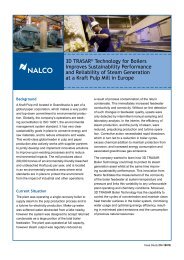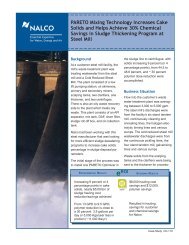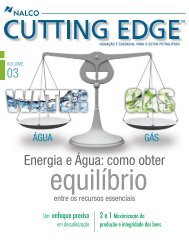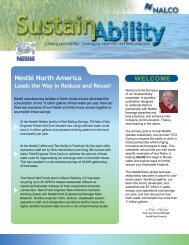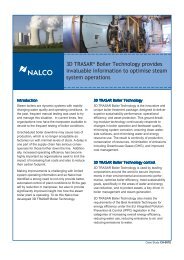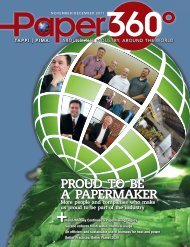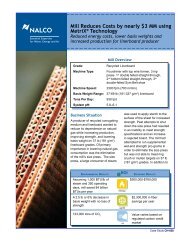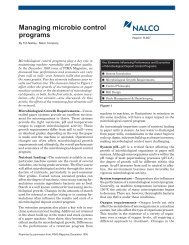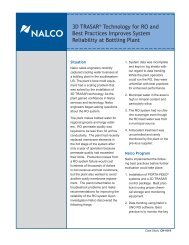New 3D TRASAR® Membrane Technology increases plant ... - Nalco
New 3D TRASAR® Membrane Technology increases plant ... - Nalco
New 3D TRASAR® Membrane Technology increases plant ... - Nalco
Create successful ePaper yourself
Turn your PDF publications into a flip-book with our unique Google optimized e-Paper software.
• P1, P2, P4 pressure values are taken from existing<br />
customer sensors. There is no sensor for P5<br />
permeate pressure, needed for normalisation, but<br />
this is a constant value (0.3 bar).<br />
• F1 permeate flow and F2 concentrate flows are<br />
taken from existing customer sensors.<br />
The following additional signals are also received by<br />
the customer’s control unit:<br />
• Pressure values (pre- and post-sand filters)<br />
• Pressure value (post-cartridge filters)<br />
• pH and ORP from fluorometer B<br />
• Concentrate conductivity from fluorometer C<br />
In order to send all of these data to the <strong>3D</strong> TRASAR<br />
unit, a splitter box was prepared to split the signals<br />
from the Programmable Logic Controller (PLC)<br />
(as shown in Figure 2).<br />
Figure 2 – Splitter box used to manage<br />
signals between the RO trains and the<br />
<strong>3D</strong> TRASAR unit.<br />
The <strong>3D</strong> TRASAR unit was connected to the<br />
internet via a <strong>Nalco</strong> Global Gateway (NGG) to<br />
record and analyse data, and to run the <strong>Nalco</strong><br />
‘UNO’ normalisation tool.<br />
Description<br />
<strong>3D</strong> TRASAR <strong>Technology</strong><br />
<strong>3D</strong> TRASAR <strong>Technology</strong> management programmes<br />
are used in many different types of water preparation<br />
and management system to deliver on-demand<br />
control and optimisation of water chemistry, continuously<br />
protecting the systems from scale formation<br />
and fouling, ensuring optimised operational efficiency<br />
and continuity of production.<br />
• Protection of systems avoids premature and<br />
costly replacement of non-renewable materials<br />
• Scale and fouling control maximises operational<br />
efficiency and reduces costs<br />
3<br />
• Better water resource management minimises<br />
the demand for costly renewable resources, and<br />
safeguards public water supplies<br />
<strong>3D</strong> TRASAR <strong>Technology</strong> is used by thousands of<br />
corporations around the world to:<br />
• Secure improvements in their environmental and<br />
economic performance<br />
• Optimise system efficiency<br />
• Help them to meet their sustainability goals,<br />
specifically in the areas of water and energy use<br />
reduction<br />
<strong>3D</strong> TRASAR technology control systems take<br />
account of the inherent variability in system water<br />
conditions, maintaining protection from scale and<br />
fouling by predicting problems and intervening<br />
before they occur. The programme controls system<br />
chemistry, dosing on-demand and minimising the<br />
amount of materials added to the system, thereby<br />
reducing costs without prejudicing system integrity.<br />
<strong>3D</strong> TRASAR <strong>Membrane</strong> <strong>Technology</strong><br />
This technology is the new generation of the <strong>Nalco</strong><br />
RO TRASAR platform for the performance management<br />
of membrane systems. <strong>3D</strong> TRASAR <strong>Membrane</strong><br />
technology allows monitoring and control<br />
of antiscalant programmes and monitoring of key<br />
parameters for the membrane system: flows, pressures,<br />
feed water temperature and conductivities.<br />
This information is collected by the <strong>3D</strong> TRASAR<br />
Control unit from <strong>plant</strong> sensors and sent to the<br />
centralised <strong>Nalco</strong> <strong>3D</strong> TRASAR website via<br />
<strong>Nalco</strong> Global Gateway (NGG) to be normalised<br />
and trended. Customers are able to access this<br />
information on their own specific web page. Furthermore,<br />
the <strong>Nalco</strong> 360 Service team checks this data<br />
on a regular basis and makes recommendations<br />
about the continuous optimisation and improvement<br />
of <strong>plant</strong> operations.<br />
The <strong>3D</strong> TRASAR unit collects data from membrane<br />
systems through:<br />
• TRASAR chemistry, ORP, pH and conductivity<br />
sensors on the unit<br />
• Signals from the existing sensors through PLCs<br />
or signal splitters<br />
• Signals from new sensors that are added if<br />
needed




